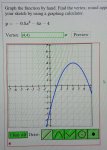mmm4444bot
Super Moderator
- Joined
- Oct 6, 2005
- Messages
- 10,958
Hate to dash your hopes even a little, doc, but a lot of software to which beginning algebra students are subjected is still sloppy. That's my viewpoint, from the late '90s through the end of 2017 -- still sloppy. My impression is that much of the presentation isn't written by instructors (the underlying content may be, but the implementation is not).… This tells me [the software requires] an exact answer, but it doesn't have to be simplified. I hope they state that somewhere, and don't just leave you to figure it out by guessing.
During the past five years, I've seen increasing use of machine teachers at the community college level, where too many students without computer experience are nontheless enrolled in beginning math courses where homework, reading assignments, and projects must be completed with a machine. Beyond inconsistent instructions and formatting, students (and employees) regularly deal with logic errors, bugs, and other technical issues. Complaints generally concern people at our (lowly) level, yet concerns about "computer error" fall on deaf ears as they rise through the heirarchy. :|
This one came with no instructions, but the student was able to guess and figure out the sequence of mouse clicks and dragging. The machine teacher liked her vertex, but not the graph. She told me she had tried many times; she thought maybe the graph was just off a little. No way to proceed but start over; you get unlimited tries. (I had to use that interface with another student, and it was not easy to drag the wildly-fluctuating parabola into correct position; the buttons at the bottom need clicking twice to do it, in the right sequence. Frustrating for that student, too.)

Screen shots from trigonometry reading assignment. Huh? and LoL!


Last edited:
